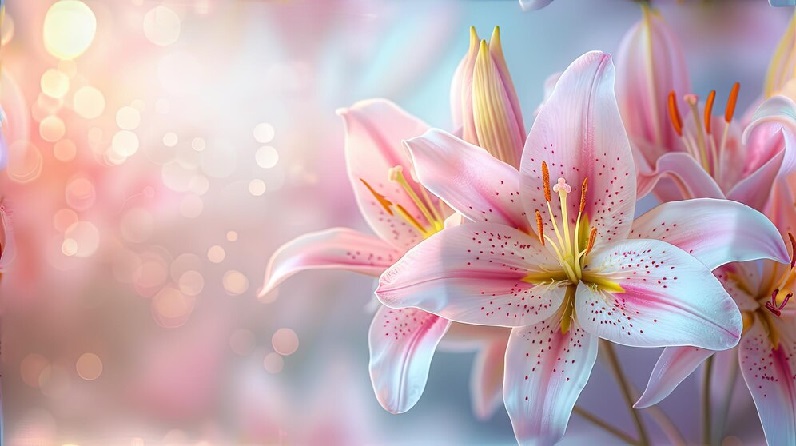Introduction to the Pink Lily Flower
The pink lily flower is a symbol of elegance, beauty, and purity Pink Lily Flower. Known for its stunning appearance and delightful fragrance, the pink lily has captivated gardeners and flower enthusiasts for centuries. Its soft pink petals, often adorned with intricate patterns, make it a favorite in floral arrangements and gardens alike Pink Lily Flower.
Botanical Overview
The pink lily flower belongs to the genus Lilium, which encompasses a variety of species. These flowers are perennial plants that grow from bulbs and are native to temperate regions of the Northern Hemisphere. The most common species of pink lilies include Lilium longiflorum (Easter Lily), Lilium speciosum (Japanese Lily), and Lilium lancifolium (Tiger Lily) Pink Lily Flower.
Growing Conditions
Soil Requirements
The pink lily thrives in well-drained, slightly acidic to neutral soil. It is essential to ensure that the soil has good organic content to provide the necessary nutrients for the lily’s growth. Adding compost or well-rotted manure can significantly enhance the soil quality, promoting healthy root development and vigorous blooms.
Light and Temperature
Pink lilies prefer full sunlight to partial shade. In regions with scorching summers, it is advisable to plant them where they can receive morning sun and afternoon shade to prevent the delicate petals from scorching. These flowers thrive in temperate climates, with ideal temperatures ranging between 60°F and 75°F (15°C to 24°C) in Pink Lily Flower.
Watering Needs
Consistent moisture is crucial for the healthy growth of pink lilies. However, overwatering can lead to bulb rot. It is essential to water them deeply but infrequently Pink Lily Flower, allowing the soil to dry out slightly between watering sessions. Mulching around the plants can help retain soil moisture and regulate temperature.
Planting Pink Lilies

When to Plant
The best time to plant pink lily bulbs is in the fall, approximately six weeks before the first frost. This allows the bulbs to establish roots before the ground freezes. Alternatively, they can be planted in early spring as soon as the soil is workable Pink Lily Flower.
How to Plant
- Choose a Sunny Spot: Select a location that receives at least 6 hours of sunlight daily.
- Prepare the Soil: Dig a hole about 8-10 inches deep and amend the soil with organic matter.
- Plant the Bulbs: Place the bulbs with the pointed end facing upwards, spacing them about 12 inches apart Pink Lily Flower.
- Cover and Water: Cover the bulbs with soil and water thoroughly to settle the soil around them.
Care and Maintenance
Fertilizing
Pink lilies benefit from a balanced fertilizer applied in early spring and again in mid-summer. A 10-10-10 (N-P-K) fertilizer works well, providing the necessary nutrients for robust growth and abundant blooms Pink Lily Flower.
Pruning
Deadheading spent flowers encourages the plant to produce more blooms and prevents seed formation, which can drain energy from the plant. After the blooming season, allow the foliage to die back naturally, as it helps replenish the bulb for the next growing season.
Pest and Disease Management
Common pests that affect pink lilies include aphids, lily beetles, and slugs. Regular inspection and prompt action, such as using insecticidal soap or hand-picking pests, can help keep these problems under control. Fungal diseases like botrytis can be prevented by ensuring good air circulation and avoiding overhead watering.
Uses of Pink Lilies
In the Garden
Pink lilies are versatile and can be used in various garden settings. They are perfect for:
- Borders: Planting pink lilies along garden borders creates a striking visual display.
- Containers: They can be grown in pots and containers, making them suitable for patios and balconies.
- Cut Flowers: Their long stems and beautiful blooms make them ideal for floral arrangements.
Symbolism and Cultural Significance
In many cultures, pink lilies symbolize prosperity, abundance, and devotion. They are often used in weddings and other celebrations to convey admiration and love. In Christian symbolism, lilies represent purity and the Virgin Mary, making them popular in religious ceremonies.
Varieties of Pink Lilies
Asiatic Pink Lilies
Known for their vibrant colors and upward-facing blooms, Asiatic pink lilies are hardy and easy to grow. They bloom early in the season and are available in a wide range of pink shades.
Oriental Pink Lilies
Oriental pink lilies are prized for their large, fragrant flowers and intricate patterns. They bloom later in the season and have a more delicate appearance compared to Asiatic lilies.
Trumpet Pink Lilies
These lilies have trumpet-shaped flowers and a strong fragrance. They are tall and make a dramatic statement in the garden.
Conclusion
The pink lily flower is a timeless classic in the world of horticulture. Its captivating beauty, ease of cultivation, and symbolic significance make it a beloved choice for gardens and floral arrangements. By providing the right growing conditions and proper care, you can enjoy the enchanting presence of pink lilies in your garden year after year.






